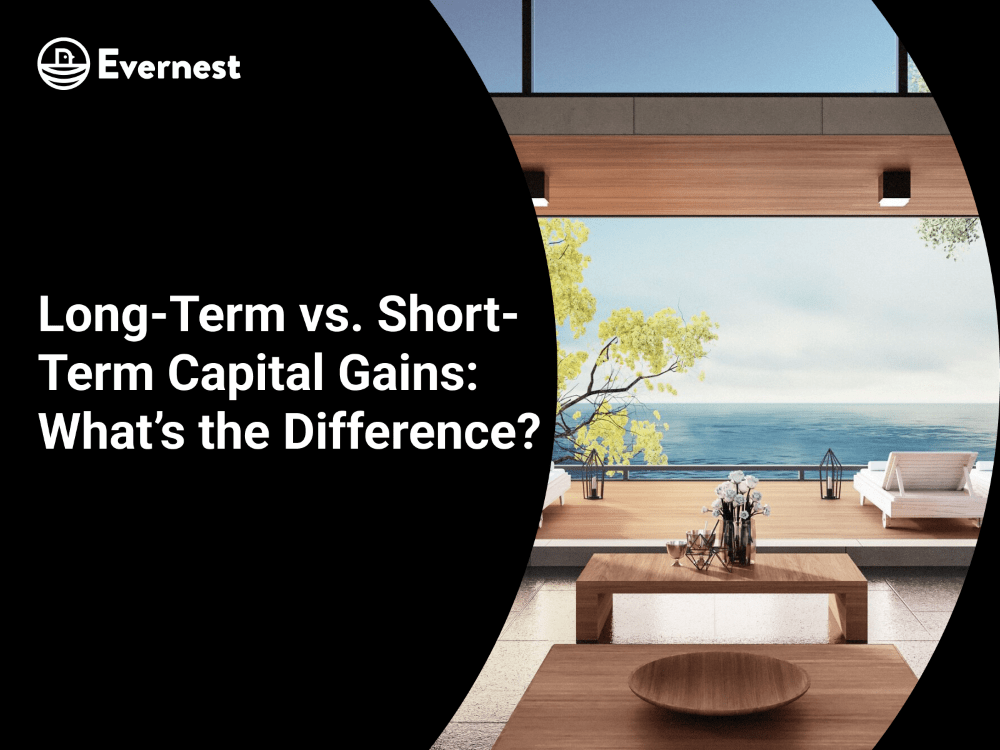Long-Term vs. Short-Term Capital Gains: What’s the Difference?
Curious about capital gains? You’re not alone. Selling capital assets, such as stocks, bonds, or real estate properties, for more than you bought them causes you to incur a capital gain. Like any source of income, the IRS wants their share of this. However, the tax consequences are more complex than salaries or rental income. The most important factor is how long you held onto the asset. This determines if your sale is a long-term or short-term gain. This subsequently impacts how much tax you pay. However, there are other variables impacting your capital gains taxes. Below, we’ll explain the basics of long-term and short-term capital gains and examine the tax consequences of each. Then, we’ll analyze key differences between the two, and look over special cases and other situations.
Long-Term Capital Gains Overview
Long-term capital gains occur when you hold an asset for more than a year before selling it for more than you bought it. The price you bought it for is called your cost basis. For example, you buy 10 shares of Stock A for $10/share, or $100, on January 1, 2022. On June 1, 2023, you sell all 10 shares when the stock trades at $15/share. Your total proceeds are $150. You incur a long-term capital gain of $50 since you held the shares for more than a year.
Long-Term Capital Gains Tax Rates
Long-term capital gains occur when you sell an asset after holding it longer than a year. The price you bought it for is called your cost basis. Before 2018, long-term capital gains rates and ordinary income tax brackets were similar. However, the Tax Cuts and Jobs Act (TCJA) — effective in 2018 for the 2017 tax year — created separate brackets for long-term capital gains taxes. These brackets are adjusted for inflation each year if needed. Here are the long-term capital gains tax rates and brackets for 2022:
| Filing Status | 0% | 15% | 20% |
| Single | $0 to $41,675 | $41,676 to $459,750 | $459,751+ |
| Head of Household | Up to $55,800 | $55,801 to $488,500 | $488,501+ |
| Married Filing Jointly | $0 to $83,350 | $83,351 to $517,200 | $517,201+ |
| Married Filing Separately | $0 to $41,675 | $41,676 to $258,600 | $258,601+ |
These are marginal, like the ordinary tax brackets. That means you don’t fall into one bracket. Instead, you spread your total income across the brackets. For instance, say you incur a $100,000 long-term capital gain. The first $41,675 is taxed at 0%. The remaining $58,325 is taxed at 15%.
Advantages of Long-Term Capital Gains
Long-term capital gains offer a few benefits:
Lower Tax Rates
Most obviously, long-term capital gains offer lower tax rates. Holding onto your investments long enough could help you keep more of your sales proceeds.
Tax Planning
Favorable tax treatment means better tax planning. You can time your long-term capital gain for a lower earning year to fall into the 0% long-term tax bracket. For instance, you might wait until retirement to sell an asset you’ve held long-term. Selling beforehand while earning a salary doesn’t disqualify you from the favorable long-term rates. However, you may fall into the 15% or 20% long-term brackets instead of the 0% bracket.
Step-Up in Cost Basis
If you pass an asset to an heir when you pass away, they get a “step-up” in the asset’s basis. This increases the cost basis to the asset’s value when you pass away, effectively eliminating your heir’s tax burden if they sell that day. For example, say you buy an asset worth $10,000. It appreciates to $100,000 by the time you pass away, and your heir receives it. The heir’s cost basis is $100,000, erasing the $90,000 of appreciation for tax purposes.
Short-Term Capital Gains Overview
Short-term capital gains occur when you sell an asset after holding it for one year or less. Returning to our previous example: you buy 10 shares of Stock A for $10/share, or $100, on January 1, 2022. You then sell all shares on January 1, 2023, for $12/share. Your total proceeds are $120. However, you incur a short-term capital gain of $50 since you held the shares for more than a year.
Short-Term Capital Gains Tax Rates
Short-term capital gains are taxed as ordinary income, like a salary or rental income. Here are the ordinary income tax brackets for 2022:
| Filing Status | 10% | 12% | 22% | 24% | 32% | 35% | 37% |
| Single | $0 to 10,275 | $10,276 to $41,775 | $41,776 to $89,075 | $89,076 to $170,050 | $170,051 to $215,950 | $215,951 to $539,900 | $539,001+ |
| Head of Household | $0 to $14,650 | $14,651 to $55,900 | $55,901 to $89,050 | $89,051 to $170,050 | $170,051 to $215,950 | $215,951 to $539,900 | $539,001+ |
| Married Filing Jointly | $0 to $20,550 | $20,551 to $83,550 | $83,551 to $178,150 | $178,151 to $340,100 | $340,101 to $431,900 | $431,901 to $647,850 | $647,851+ |
| Married Filing Separately | $0 to $10,275 | $10,276 to $41,775 | $41,776 to $89,075 | $89,076 to $170,050 | $170,051 to $215,950 | $215,951 to $539,900 | $323,926+ |
The TCJA did not fundamentally change how short-term gains are taxed. Instead, since it adjusted the income tax brackets, the short-term capital gains tax brackets also shifted. It’s important to note that short-term capital gains are incurred when selling after holding for one year or less, not less than a year. That means you must wait one year and one day to qualify for long-term capital gains treatment.
Advantages of Short-Term Capital Gains
Short-term capital gains may not offer the same tax rate advantage, but they do provide investors with some benefits.
Less Uncertainty
Holding onto an investment for a long time can cause you to enjoy significant appreciation. But there’s also the risk of losses incurred through future events. For example, a recession could happen one year after you purchase your stock. Your shares may plummet, causing you to take a loss. On the other hand, maybe you sell your shares eight months after purchase when the market peaks. You pay more taxes, but your gains may outweigh any write-offs from a capital loss. Similarly, tax rates may change. At worst, the government might theoretically raise long-term capital gains rates or ax them altogether. This is not likely, but demonstrates the downside of uncertainty.
More Streamlined Taxes and Finances
Holding an investment longer than a year means you may have to track taxable consequences across several years. This can add complications to your taxes. On the other hand, buying and selling in the same year means you may not have to track that asset for more than one tax year. That said, the short-term gain must occur in the same calendar year.
Long-Term vs. Short-Term Capital Gains: The Key Differences
In this section, please mention the key differences between long-term and short-term capital gains.
Special Cases For Capital Gains
In this section, please mention which assets are counted as capital gains. Mention these points and talk about each of them a little bit
Investment Real Estate
Investment real estate cost basis is a bit more complex than assets like stocks and bonds. Investors can depreciate the property every year to represent wear and tear. This depreciation is a tax deduction, helping the investor offset rental income. However, when selling a property, you must add back depreciation to calculate taxable capital gains. This is called depreciation recapture. Depreciation recapture is taxed as ordinary income but capped at 25%. Imagine you pay $100,000 for a rental property and depreciate $3,000 throughout owning it. You are treated as if you paid $97,000 for the property. After two years, you sell it for $110,000 for a $13,000 capital gain. However, the $3,000 recapture is taxed as ordinary income, capped at 25%. The remaining $10,000 is taxed at the long-term capital gains rates. Additionally, you can often add costs associated with obtaining the mortgage and major improvements to the cost basis.
Collectibles
Collectibles are items like coins, stamps, art, and antiques. This is not an exhaustive list. Work with a tax advisor if you are uncertain whether you may have sold a collectible. Collectibles held for longer than one year are taxed at 28%, regardless of your gain size or income. Short-term gains on collectibles — incurred by selling within a year of buying — are taxed at your ordinary income tax rate.
The Home Sale Exclusion
Selling your principal residence can qualify you for a special tax deduction because it partially counts as personal property. You could deduct the first $250,000 in capital gains from selling your principal residence. That increases to $500,000 if you qualify for and select the Married Filing Jointly status. However, since you cannot deduct losses on the sales of personal property, losses on the sale of your home are not deductible. For example, a single taxpayer purchases a home for $200,000. They sell it for $500,000. The total proceeds are $300,000. Filing single, they can deduct $250,000. That leaves them with a $50,000 capital gain. To qualify for this exclusion, you must have owned and used your home as your main home for two out of the last five years prior to sale. These years can be nonconsecutive. Of course, we must also define “main home.” The IRS does not concretely define what qualifies as a “main home” if you own or live in more than one property. However, IRS Publication 523 provide numerous facts and circumstances that can help you determine what qualifies. Like rental real estate, you might be able to add the costs of major improvements to your cost basis to reduce capital gains.
Other Investment Exceptions
High-income individuals may be subject to net investment income taxes on capital gains. This taxes your investment income, including capital gains, by another 3.8% if your modified adjusted gross income (MAGI) exceeds certain limits:
| Filing Status | MAGI Threshold |
| Single | $200,000 |
| Head of Household | $200,000 |
| Married Filing Jointly/Surviving Spouse | $250,000 |
| Married Filing Separately | $125,000 |
Capital Gains and State Taxes
This article covers the federal tax consequences of capital gains. States and localities may impose taxes on these gains as well. Some states may also offer tax breaks on federally taxable capital gains. As of 2022, the following states have no income or capital gains taxes:
- Alaska
- Florida
- Nevada
- New Hampshire
- South Dakota
- Tennessee
- Texas
- Washington
- Wyoming
If you’re investing in out-of-state real estate, you may pay taxes in the state in which your property is located. Make sure to understand state tax laws before investing in any particular state.
Final Thoughts on Long-Term vs. Short-Term Capital Gains
Tax policy incentivizes investors to hold investments longer by offering favorable tax treatment. Additionally, holding investments longer allows for more potential appreciation. In the case of real estate, it could mean more depreciation deductions as well. Regardless, working with a tax professional is always advisable if you have questions or concerns. They will help you minimize taxes on your capital gains to the maximum degree allowed.


